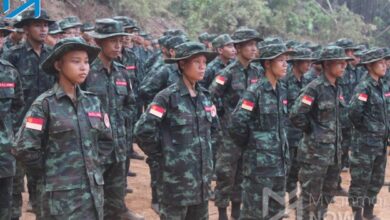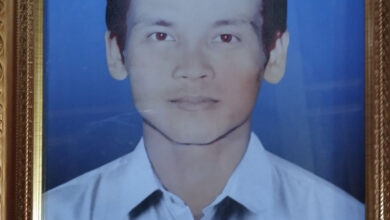
Eleven members of a local defence force and three civilians were killed in a Tuesday clash with junta forces in the resistance stronghold of Khin-U Township. The battle followed an internet blackout imposed on most of Sagaing Region by the military last week marking what locals speculated would be the start of an intensified bloody crackdown on villages in Upper Myanmar.
An alliance of resistance groups from Khin-U and Shwebo townships attacked a military column of around 40 soldiers that had ransacked Thein Taw village, 15 miles from Khin-U town one day earlier. The ensuing battle took place at around 9am in an open field, without cover, with the guerrilla fighters significantly outgunned.
“They exchanged gunfire for only five to 10 minutes and the defence forces were forced to retreat as they ran out of ammunition,” said a member of the defence force alliance who on Wednesday helped retrieve the bodies of others who had been killed.
“The military continuously fired 44mm shells and did away with all of the injured resistance fighters,” he added.

Another member of a defence force involved in the clash said that his group and their allies were mostly armed with handmade muskets, rather than automatic weapons which may have been a better match for the junta’s weapons.
“We had only 2 AK rifles with us. The rest were just handmade single-shot rifles,” he explained, adding that the military “fired heavy weapons non-stop.”
More than 30 empty shells from 44mm artillery were reportedly found on the battlefield the following morning.
He said that he had found the bodies of his fallen comrades piled in the field, as well as the cremated body of a junta soldier and first aid supplies.
Six of the slain resistance fighters were members of the defence force in Thayet Pin Wun village in Shwebo, two were from a group in Khin-U’s Mhan Taw, and three were from one in Thein Taw, according to the first local defence force member who spoke to Myanmar Now.
“It’s very likely that the majority of them were captured alive and then killed,” he said, noting that many of the bodies had injuries, including bruising.
The bodies of three locals abducted by junta troops from the nearby village of Kyun Lel on Monday were also found piled on top of one another in the field, with their hands tied behind their backs.
All 14 people were cremated on Thursday.
The junta column involved in the clash originally was made up of 80 soldiers and left Ye-U Township for Khin-U on March 5. They proceeded to raid the villages of Mhan Taw and Dan Kone in western Khin-U, killing three civilians and torching more than 100 homes, according to members of defence forces in the area.
The troops then attacked Kyun Lel and In Pauk and occupied Nyaung Pin Gyi Su village on Monday.
At this point, the column divided into two groups of 40 soldiers, with one ransacking the village of Muu Thar and another raiding Thein Taw, both located a half-mile from Nyaung Pin Gyi Su.
On Tuesday, the same day that local defence forces attacked the military unit that raided Thein Taw, they also ambushed the group that had targeted Muu Thar. No members of the resistance were reportedly killed in that battle, but the military is accused of burning down some 15 homes in the village.
Last month nearly 20 members of the local defence forces in Khin-U were killed in battles with the Myanmar army in Myo Thit and Thayet Kan villages as well.
Another local who is both the leader of a village defence force and part of the group that retrieved the bodies of resistance fighters from Thein Taw speculated that lives were lost on Tuesday because of the lack of training and strategy among the area guerrilla groups.
“We need to be able to plan systematically in battles. We can only win the war if the [defence force] soldiers know how to obey orders. We can’t fight without discipline,” he said.
The leader of another defence force active in western Khin-U said that the fighters need to be better armed before going into battle with the junta.
“The lack of weapons is the main problem now. We desperately need to be able to guess the trajectory of the military’s weapons,” he said. “We also need to assess the range of the junta’s rifles and the defence of our muskets.”
“Taking up shotguns instead of using explosives, which is the guerrilla technique, has led to a lot of unnecessary deaths,” he added.
![Resistance fighters holding heavy weapons ammunition in central Myanmar. (Photo: Freedom Revolution Force [FRF])](https://myanmar-now.org/en/wp-content/uploads/sites/5/2024/04/438869056_443267851680128_1706386881626943924_n-390x220.jpeg)


